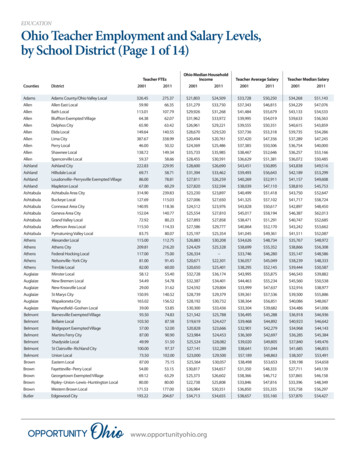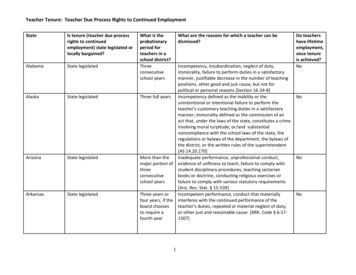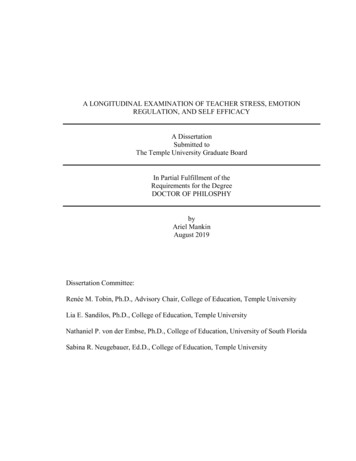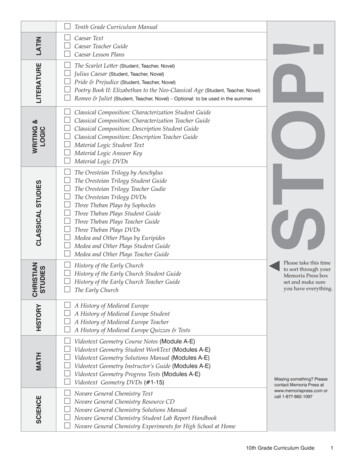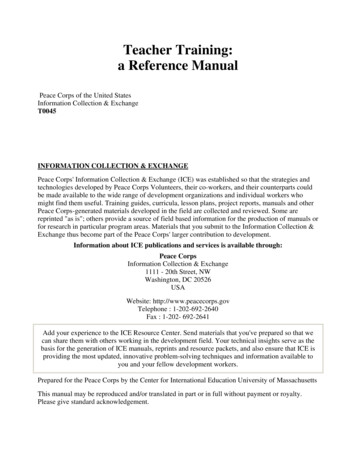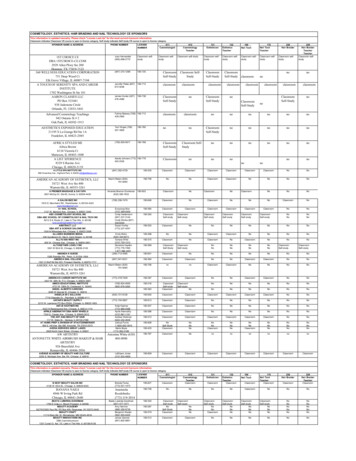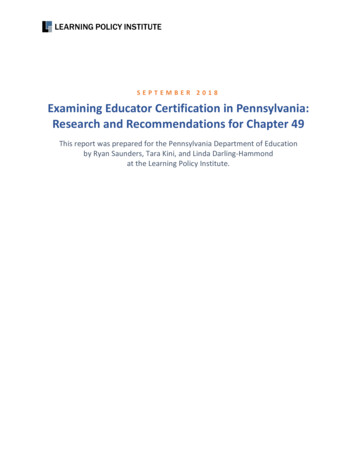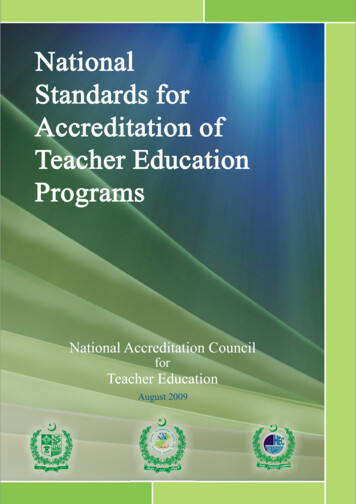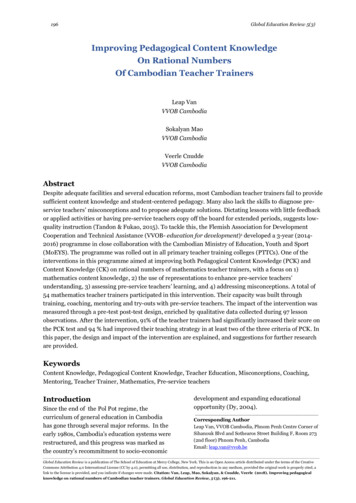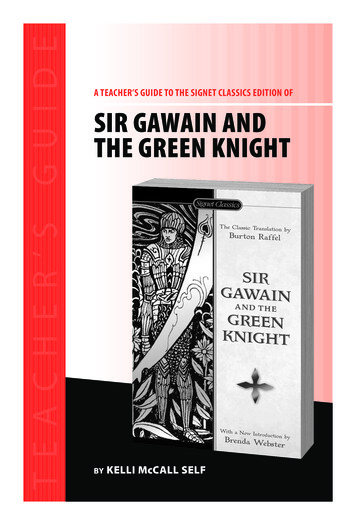
Transcription
G U I D ET E A C H E R’SA TEACHER’S GUIDE TO THE SIGNET CLASSICS EDITION OFSIR GAWAIN ANDTHE GREEN KNIGHTBYDR Gawain TG 100912a.indd 1KELLI McCALL SELF10/24/124:55 PM
2A Teacher’s Guide to Sir Gawain and the Green KnightTABLE OF CONTENTSINTRODUCTION .3LIST OF CHARACTERS .3SYNOPSIS OF THE POEM .4PREREADING ACTIVITIES .6I. BUILDING BACKGROUND KNOWLEDGEIN HISTORY AND LITERATURE .6II. BUILDING BACKGROUND KNOWLEDGETHROUGH INITIAL EXPLORATION OF THEMES . 10DURING READING ACTIVITIES. 13I. DISCUSSION QUESTIONS . 13II. ACTIVITIES TO GENERATE RESPONSEAND EXPLORATION OF THE TEXT . 15AFTER READING ACTIVITIES . 16I. TEXT-BASED TOPICS FOR ESSAYS AND DISCUSSIONS . 16II. GROUP AND INDIVIDUAL PROJECTS THAT EXTEND THE TEXT . 17III. PARALLEL OR EXTENDED READING . 19IV. ADDITIONAL RESOURCES . 20ABOUT THE AUTHOR OF THIS GUIDE . 21ABOUT THE EDITORS OF THIS GUIDE . 21FREE TEACHER’S GUIDES . 23Copyright 2012 by Penguin Group (USA)For additional teacher’s manuals, catalogs, or descriptive brochures,please email academic@penguin.com or write to:PENGUIN GROUP (USA) INC.Academic Marketing Department375 Hudson StreetNew York, NY 10014-3657http://www.penguin.com/academicIn Canada, write to:PENGUIN BOOKS CANADA LTD.Academic Sales90 Eglinton Ave. East, Ste. 700Toronto, OntarioCanada M4P 2Y3Printed in the United States of AmericaDR Gawain TG 100912a.indd 210/24/124:55 PM
A Teacher’s Guide to Sir Gawain and the Green Knight3INTRODUCTIONCue: sweeping orchestral musicCue: close up of horse thundering through the forestCue: overly dramatic narrator“In a world where men are men and monsters rule,In a time when nature is a formidable foe,One man holds the fate of a kingdom in his hands whileOne woman holds the key to his heart—A tale of violence, intrigue, treachery, romance, and magic.”Although it’s not the latest blockbuster movieof the summer, Sir Gawain and the GreenKnight combines the elements of traditionalMiddle English literature with colorful, descriptive language, a compelling plot, and violence enough to please even a modern audienceof teens reared on Avatar and The Avengers.In the classroom, Sir Gawain and the GreenKnight will spark discussions about pride,bravery, honor and humility—virtues relatable to the lives of young adults today. It canbe used as a stand-alone text or as a companion to modern pieces of literature whichfocus on archetypes such as the hero, thetrickster, the temptress, the journey or questand the temptation or test.This guide offers information and activitiesdesigned to spark interest in the poem andactivate students’ prior knowledge of the historical and literary time period of the MiddleAges. The During Reading activities will helpkeep discussions on track, allowing studentsto notice connections they might havemissed, and include activities designed forstudents to reflect and extend their knowledge of the poem and its thematic elements.The After Reading activities encourage students to apply their knowledge and focus onthe use of Web 2.0 and 21st Century tools.LIST OF CHARACTERSKing Arthur: young and beardless; knowsnothing of fear; stresses entertainment beforefood; holds an opulent court in which excessseems to be common and the knights have noneed to fight for territory or defenseBercilak (the Lord of the House): Gawain’saccommodating and cheerful host at thecastle before he meets the Green Knight atthe Chapel; tall and strong with a beard thecolor of a beaver and a fiery red faceSir Gawain: humble, thoughtful, and courageous; gallantly volunteers to take the challenge of the Green Knight in Arthur’s placeBercilak’s Wife (the Lady of the House):stunningly beautiful, smart, and demure;tempts Gawain three times to kiss her and toseduce her while her husband is otherwiseoccupied; presents Gawain with the greensilk girdle he believes will save his lifeGreen Knight: huge, square, thick, and, atthe same time, graceful; a big, green mysticalknight on a big, green mystical horse; revealedto be Bercilak in disguise (Gawain’s host)doing Morgana Le Fay’s biddingMorgana Le Fay: Arthur’s half sister andGawain’s aunt; concocts the challenge inhopes of scaring Queen Guenevere to deathand bringing shame on Camelot; may be theold woman who accompanies Bercilak’s wifeGuenevere: Arthur’s wife; Queen of CamelotDR Gawain TG 100912a.indd 310/24/124:55 PM
4A Teacher’s Guide to Sir Gawain and the Green KnightSYNOPSIS OF THE POEMPart One: (ll.1-490)Celebrating Christmas and preparing forNew Year’s Day, King Arthur and his courtpraise their good fortune with feasting andcelebration. Suddenly, a ghastly green knightmounted on a huge green horse bursts in,interrupting the merriment. He first praisesArthur and the reputation he and his knightshave for bravery, strength, and pride. Then,he proposes a challenge: any knight in thecourt can use his axe to take a swing at himwhile he sits still. In return, the knight mustagree to take a blow from the challenger’s axein one year’s time. When the court sits instunned silence, the Green Knight mocksthem, wondering where all the courageousmen have gone. Shamed, Arthur angrily volunteers to take the challenge himself untilGawain humbly asks leave to accept. Arthuragrees and reminds Gawain of the details ofthe bargain. Gawain braces himself andswings the mighty axe, beheading the GreenKnight swiftly and easily. The now headlessGreen Knight picks up his head, holding it bythe hair, and mounts his horse. The headopens its eyes and reminds Gawain that hewill be expected at the Green Knight’s Chapelin one year’s time to complete his end of thebargain. Then, as quickly as he arrived, theGreen Knight is gone in a flourish, his headin his hands. Arthur, masking his true feelings of fear, insists the queen and the ladiestake no note of the events and proceed withthe celebration. They hang the huge axeagainst a tapestry and continue celebrating.Part Two: (ll. 491-1125)The seasons change and Gawain’s dreadedappointment approaches. He is opulentlyarmored and prepared for travel. In remembrance of his dedication to truth and his faithin God, his shield is decorated with a pentangle star (representing five knightly virtues)and a portrait of Mary (to remind him to bebrave). Arthur sends Gawain on his way,regretting his decision to let the most promis-DR Gawain TG 100912a.indd 4ing of his knights accept the challenge.Gawain encounters many obstacles on hisjourney: dragons, wolves, satyrs, trolls, andthe freezing elements. After thrice desperatelypraying to Mary to send him shelter andattempting to atone for his past transgressions, he finally reaches a huge castle. Thedrawbridge is lowered and he is welcomed tothe castle with enthusiasm. The Lord assuresGawain he is pleased to have him as an honored guest and invites him to celebrateChristmas with them. Then he meets theLady of the House, who is lovelier thanGuenevere, and her companion, a hideouslyugly old woman. Accommodations and celebrations at this castle are even more lavishthan at Camelot, and Gawain is lulled intocomfortable companionship with the Lord.After the feast, he shares the story of theGreen Knight and his terrible errand, vowingthat he’d rather “die than fail.” The Lordencourages Gawain to take advantage of hishospitality: drink, eat, sleep, keep good company with his wife. As he parts from Gawain,he proposes a bargain between them: he willshare with Gawain whatever he catches at thenext day’s hunt as long as Gawain shareswhatever he gains during his day at the castle.Part Three: (ll. 1126-1997)The Lord and his knights leave very early thenext morning for the hunt, delighting in thechase. Gawain, still asleep, is awakened suddenly by a noise at the door, the Lady of theHouse quietly entering his room. He pretends to sleep, but, when she does not leave,he “wakes” and engages in courtly flatterywith her. She subtly indicates that she isinterested in him and his reputation as aknight, finally mentioning that a worthyknight would not hesitate to kiss a lady. Heobliges and she leaves the chamber satisfied.Meanwhile, the Lord has finished his hunt;the poet pays particularly gruesome attentionto the slaughter and butchering of the deerthe hunters have killed. When the Lordreturns to the castle, he presents the venison10/24/124:55 PM
A Teacher’s Guide to Sir Gawain and the Green Knightto Gawain who praises the quantity and quality of the bounty. The Lord’s end of the bargain met, Gawain courteously kisses the Lordas a noble knight, mentioning that the kisswas all he won that day. They laugh and feastlong into the night, agreeing to the samebargain for the next day.Again, early in the morning, the Lord leavesfor the hunt. This time, the object is a wildboar, which poses quite a challenge. Oncemore, the Lady approaches Gawain while heis asleep. Once he wakes, she tells Gawain toteach her the “ways of love.” He does notbelieve that she is ignorant of those ways andgracefully evades her advances. He offers herhis lips for as long as she likes; they kiss twiceand then she eventually leaves. On the hunt,the Lord continues to struggle with the ferocious boar, finally wrestling it to the groundand stabbing it with his sword. The poetagain spends time describing the butchering.The Lord cuts off the boar’s head and bringsit to Gawain on a stick. Gawain is pleasedand presents the Lord with two kisses. Theyfeast joyously, while the Lady of the Houseflirts openly with Gawain who is embarrassedby her overt attention. As the feast windsdown, the Lord proposes the bargain for onemore day.Morning arrives and the Lord and his menare ready to hunt again. This day’s quarry is afox. As the fox cleverly evades capture, theLady of the House prepares to visit Gawainagain, dressing provocatively, expecting tosucceed in her seduction. Dreams of hisimpending encounter with the Green Knighthave given Gawain a fitful night’s sleep andhe is comforted by her visit. Despite her bestefforts, Gawain once again refuses to involvehimself in an affair, citing his deep respect forthe Lord of the House. She relents and offersGawain a dazzling ring as a token of her affection. Gawain refuses it as it is “too rich a gift.”She then offers Gawain her green silk belt,which he also refuses. However, when theLady explains that whoever wears the belt willnever be killed, Gawain accepts it, thinkingof his battle with the Green Knight. Shebestows upon him three kisses and leaves.DR Gawain TG 100912a.indd 55Meanwhile, the Lord and his greyhoundshave finally cornered the sly fox; they surround and kill it. When the Lord returnsfrom the hunt, Gawain presents him with thethree kisses, but keeps the belt to himself. TheLord is embarrassed to present to Gawain thebedraggled hide of the lone fox. The peoplein the castle are sad Gawain will be leavingthem the next day. At this point, the poeturges us to pay attention just a little longer tofind out how his adventure ends.Part Four: (ll.1998-2531)The day dawns stormy and once again Gawainis armored and prepared for battle. This time,he has the protection of the green silk beltwound twice around his royal red tunic. Hebestows a blessing on the castle and its inhabitants, and, with the help of a guide, rides offin search of the Green Knight’s chapel. Theguide attempts to dissuade Gawain fromapproaching the Knight, convinced that hewill surely die. Gawain will hear nothing ofhis protests vowing that God will guide him.As Gawain approaches the chapel, he hearsthe noise of a grinding stone and knows thatthe Knight is preparing the axe for him. TheKnight is ready for Gawain and frolics abouton the shore waiting for his arrival. TheKnight praises Gawain for keeping theirappointment and gets down to business.Gawain bares his neck for the axe blow, butflinches slightly as the Knight swings the axe.The Knight stops the blow and admonishesGawain for flinching, citing his own steadfastperformance a year ago. Gawain assures theknight that he will not flinch again. TheKnight raises the axe and brings down a hardblow which only nicks Gawain’s neck. Gawainis elated and ready to leave the chapel untilthe Knight reveals that he is, in fact, the hospitable Lord of the House, Bercilak de Hautdesert. He was directed by Morgana Le Fay, awitch who lives in his castle, to bring the scarychallenge to Arthur’s court to test their chivalrous reputation. He concludes that Gawainalmost passed the test since he gave back thekisses but failed in that he kept the belt to savehis own life.10/24/124:55 PM
6A Teacher’s Guide to Sir Gawain and the Green KnightGawain is instantly ashamed and throws thebelt at Bercilak, no longer wanting to bereminded of his cowardice. He refuses Bercilak’s invitation to return to the castle andreturns to Camelot, wearing the belt as a signof his shame. Embarrassed, he shares his storywith Arthur who, in support of Gawain,decides all knights and ladies of Camelot willforever wear a belt of green as a badge of honor.PREREADING ACTIVITIESThese activities are designed to draw on anddeepen students’ background knowledge ofthe Middle Ages, poetic forms, archetypes,and themes they will encounter as they readthe poem. Choose and adapt the activitiesthat best meet students’ needs and yourteaching goals (Note: Consult other Teacher’sGuides to Signet Classics; they contain ideasthat can be adapted to prepare students toread and interact with this text).I. BUILDING BACKGROUNDKNOWLEDGE IN HISTORYAND LITERATUREUnderstanding the HistoricalContext of the Poem:The Middle Ages1. Poll your students’ prior knowledgeabout the Middle Ages as a starting pointfor discussions and a way to reflectthroughout the unit. Consider daily life,leisure, food, hygiene, society, the church,gender roles, chivalry, and warfare. Createa GoogleDoc spreadsheet, and as yourstudents call out answers, type them intothe spreadsheet. Don’t worry about repetitions. Accept everything. After collecting the responses, paste the contents ofthe spreadsheet into a word cloud program such as Wordle (www.wordle.net).Using Wordle can instantly provide greatanalytics without having to break out thecalculator. The words that appear numerous times will be larger and bolder thanother words. Print this word cloud orembed it into your class website. It wouldbe a great idea to do this very same activity at the end of the unit to mark howDR Gawain TG 100912a.indd 6perceptions have changed as a result ofthe information in the unit.2. Prior to beginning this activity, go toWeebly for Education at http://education.weebly.com/ (Weebly) to create aclassroom account and set up accountsfor the members of your classes or forgroups as you divide them (directions areon the site). Assign each group an aspectof life in the Middle Ages such as food,work, feudalism, religion, weaponry, religion, literacy, and hunting as a socialactivity. After researching, have studentscreate Weebly sites with the informationthey found. Once they’ve created thesites, have them present the information,noting when their perceptions of theMiddle Ages differed from what theylearned in their research. Some usefulweb sites to begin this research are:http://www.domesdaybook.co.uk/life.html (The Domesday Book ges/feudal.html (Part of theAnnenberg Western Tradition series)Another interesting resource is CrashCourse, a series of educational videos created by self-professed nerd, author, blogger, and YouTube celebrity John Greenfocusing on World History. He useshumor and hip wit to discuss historicalhappenings and concepts that have previously been tedious to study for most students. Although some of the delivery issilly, the historical basis is sound. Youmight wish to establish the context of theMiddle Ages by having students view“The Dark Ages” at http://www.youtube.com/watch?v QV7CanyzhZg Have stu-10/24/124:55 PM
A Teacher’s Guide to Sir Gawain and the Green Knightdents listen for the reasons the MiddleAges were considered dark and to thedescription of feudalism. Have themcompare their answers in groups beforethe whole class discussion.3. Without the leadership of centralizedgovernment, many developing nationshistorically relied on some kind of feudalsystem based on territorial rights. Thissystem provided a chain of commandwith regard to responsibilities, but itsrigid system of rules rarely allowed anyopportunity for advancement. Brainstorm with your students what theyunderstand about feudalism and listthese ideas in a graphic organizer. Askstudents who have seen the film, AKnight’s Tale (written, directed, and produced by Brian Helgeland, 2001), inwhich a hero aspires to be a knight eventhough he is not of noble birth, to add tothe list of ideas about feudalism. You canalso show your class the trailer to the filmwhich is available at http://www.youtube.com/watch?v zH6U5y086hw to aidtheir thinking.Conduct a Google search with the classfor images of the feudal hierarchy. Selectone of these images, asking students toexplain any additional information theimage provides about the feudal system.Discuss with students: Where do theythink most of the population fit into thehierarchy? What would be the nature ofthe relationship between the nobles andthe peasants? Why did people accept thissystem? What did they gain? What didthey lose? What was the basis of thissystem?4. To begin to understand the influence ofChristianity on the poet, have studentscreate timelines tracing the history ofChristianity in Europe during the MiddleAges from 449-1066 using online encyclopedias such as Britannica or Encyclopedia.com, if the school has a paidsubscription to such a service. (www.britannica.com, www.encyclopedia.com).Have students create interactive multi-DR Gawain TG 100912a.indd 77media timelines to showcase their findings on Timeglider at www.timeglider.com. Timeglider gives students the ability to embed text, photos, video, andaudio, ensuring a more active experience.Be sure to point out that the manuscriptcontaining Sir Gawain and the GreenKnight was first shared around the late14th century, while the beginning of thechivalric age was more likely in the 6thcentury. Discuss with students: Since theGawain poet is a Christian (check thePreface, p. 13), re-telling an ancient storyabout a challenge to honor and pride,what might be the message he wants toconvey to his listeners?5. Sir Gawain and the Green Knight survivedas part of a handwritten illuminatedmanuscript containing three other narrative poems: “Pearl,” “Purity,” and“Patience.” All are thought to have beenwritten by the same author, according tohandwriting and style analysis. Illuminated manuscripts offer a rare glimpseinto the culture of the audience at thetime of authorship. As with the PearlManuscript, many times the illustrationsare not relevant to the story on the pages,but rather artwork depicting cultural orreligious subjects. Gain a glimpse intothe life of people in the Middle Ages byvisiting the British Library’s VirtualBooks online site at l/index.html# Here you can find scanned copiesof original illuminated manuscripts.One, in particular, called Glimpses intoMedieval Life is useful as primary sourcematerial for contextualizing life duringthis time period. Access the site and havestudents study the pages, reading or listening to the accompanying narration,noting on a T-chart where they inferfrom the illustrations information thatsupports or refutes their assumptionsabout life in the Middle Ages in the following categories: Life, Religion, andTechnology. In the left column, brainstorm assumptions. In the right column,10/24/124:55 PM
8A Teacher’s Guide to Sir Gawain and the Green Knightlist information inferred from the illustrations in the manuscript.Understanding theGenre of the RomanceAdditional manuscripts:http://www.kb.nl/manuscripts/browse1. Direct students to research the meaningof the term romance as a genre of literature by having them check several siteslisting the etymology of words such asDictionary.com or The Online Etymology Dictionary (www.dictionary.com andhttp://www.etymonline.com/index.php).More information about ion/for teachers/curricula/manuscripts/background1.htmlBBC Program-Illuminations:The Private Lives of Medieval Kingshttp://www.bbc.co.uk/programmes/b019h3g26. One of the most interesting facets ofteaching about the literature of theMiddle Ages is the romanticizing of thewar hero who came to be known as thelegendary King Arthur. In this activity,have your students access The Middle Ageswebsite (http://www.themiddleages.net/people/king arthur.html) and, using adouble bubble map, compare and contrast the historical theories about Arthurwith the romantic version, said to havebeen created by Geoffrey of Monmouthin his History of the Kings of Britain. Whyis it that we, as a society, believe thelegend more often than the history?What aspects of the legend are improbable? What events in history parallelclosely events in the legend? Also interesting to note are the writings of geographers and historians who enjoy tracingthe historical basis for the King Arthurlegend and the website of Caerleon,thought to be the location once known as“Camelot.” Other useful resources are:h t t p : / / w w w. i n d e p e n d e n t . c o . u k rthur-2024729.htmlhttp://www.caerleon.net/DR Gawain TG 100912a.indd 8Ask them to look up variations of“romance,” such as romantic and romanesque (or accomplish this as a wholegroup, projecting the site results). Afterthey’ve explored the etymology of theterm, give students a 12x12 sheet of aluminum foil and have them each sculpt asymbol representing an aspect of romanceas it applies to the Middle Ages (you canpurchase precut sheets for ease of use).After they have shared what their sculptures represent, display them in theclassroom so the class can go back tothem while reading the poem to discusshow their idea of romance as a genre ofliterature is developing.2. Have students read a brief selection fromLe Morte d’Arthur, book 1, chapter 25, inwhich Arthur gets the sword Excaliburfrom the Lady of the Lake. It is available .Ask them to list the elements of the story,such as the adventure, the quest of thehero, magic, the wise man (Merlin), thelady, the warfare of knights, the code ofhonor. Then explain to students thatthese elements occur in the stories of theMiddle Ages which are called romancesor chivalric romances. Explain how thesestories of the adventures of knights werepopular among the aristocrats of thetime. Discuss with students: Why, do youthink, the nobles enjoyed these stories?Elements of these stories continue to beused in contemporary film and literature.Why? What is universal in these stories?10/24/124:55 PM
A Teacher’s Guide to Sir Gawain and the Green Knight3. In groups have students read variousmedieval codes of chivalry. A good sourceis the Baronage page at ve students identify specific rules thatrelate to the Church and Christianity andthose that only spell out humane behavior. Have students review their findingswith the whole class and discuss how theideal knight would behave when confronted with an enemy or interactingwith his lord, a lady, a widow, and anorphan. Ask if students find anythingsurprising in the codes.4. To help students understand the code ofchivalry and the expectations of knightlybehavior, ask them to read the portrait ofthe Knight and Squire in Geoffrey Chaucer’s Canterbury Tales which was writtenaround the same time as Sir Gawain andthe Green Knight (see p. 14 of the Prefacefor speculations about the date of thepoem). A side-by-side translation of MiddleEnglish into Modern English is availablefrom the Medieval Sourcebook para.htmlHave students compile a list of the character traits of the Knight and his son, theSquire. Then discuss Chaucer’s assessment of each character. Who does headmire more and why? What are thequalities of a knight and what behaviorsare expected of knights?Understanding Literary Devices1. The “bob and wheel” metrical style ofpoetry, commonly associated with thealliterative style of Sir Gawain and theGreen Knight, is comprised of a short,one or two-stress “bob” followed by fourthree-stress lines which are the “wheel.”The rhyme scheme is ABABA with thesecond and fourth lines of the wheelrhyming with the bob. Most moderntranslations of Sir Gawain and the GreenKnight have all but done away with theintended meter and rhyme of the poem.DR Gawain TG 100912a.indd 99However, Burton Raffel, the translator ofthe Signet Classics edition stayed true tothe poet’s intent by including, whereverpossible, this poetic device (pp. 152-153of the “Afterword”). Use the originalMiddle English translation on pp. 10-11of the “Preface” in the Signet Classicsedition and have students identify thebob and wheel, noting the meter andrhyme. The companion translated linesbegin on Line 421 in the text. Now, havestudents flip through the text of SirGawain and the Green Knight choosingbob and wheel stanzas at random. Havethem identify the meter and rhyme,noting when it was kept true to the original form and intent. For a definition ofbob and wheel and a further examplestudents can be directed to http://web.cn.edu/kwheeler/lit terms B.html.2. Archetypes are recurring characters,images, or situations that are found acrossmultiple cultures and that therefore speakto some universal truth of human experience. Carl Jung, a psychologist and contemporary of Freud, theorized thatarchetypes express the unconscious mindand that humans have access to a collective unconscious that explains commonpatterns of behavior. Reading the poem,students will encounter the archetypes ofthe trickster, the temptress, and the heroon a journey or quest.The trickster is someone who plays tricksand generally exhibits unconventionalbehaviors. Students may be aware oftrickster characters from the study offolklore, such as Robin Hood in Britishtradition and Brer Rabbit from UncleRemus Tales. Ask students to make a listof the common behaviors or characteristics of these characters. What inferencescan students make about this type ofcharacter? Do they mean to do harm toothers? What is their role? You canremind students of their ideas when theclass first encounters the Green Knightwho appears at Arthur’s Christmas feastas “half an ogre, a giant,/But clearly the10/24/124:55 PM
10A Teacher’s Guide to Sir Gawain and the Green Knightbiggest creature in the world” (ll. 140141) and totally green from head to foot.Does the poet’s description alert the listener/reader to the possibility that theknight is a trickster?The temptress is beautiful and seductive,intelligent and manipulative. She temptsthe hero generally to give into immediatepleasure and to forget his duty or responsibility. In classic myths, the sirens calledmen to their death by their pleasurablesongs. Ask students to name some classical, biblical, or contemporary examplesof the temptress. What do these characters have in common? Are some moredangerous than others? What is their rolein the testing of the hero/heroine?II. BUILDING BACKGROUNDKNOWLEDGE THROUGHINITIAL EXPLORATIONOF THEMESMan vs. NatureHave students create their own Google Mapto locate and pinpoint the following places,traditionally thought to represent Gawain’sjourney (there are lots of tutorials on Google,https://maps.google.com/ and on YouTube ifthis is your first time creating maps): Caerleon (Geoffrey of Monmouththought this to be the basis for Camelot) Anglesey Islands (mentioned in line 698) Holywell (line 700) Wirral (lines 700-701) Other locations: the River Dee, RiverMersey, Peak District, Roaches, and Lud’sChurch in Staffordshire (thought to bethe location of the Green Knight’s Chapel)After noting the topographical features ofGawain’s journey, use the locations on themap and a weather service such as Yahoo! orUK Weather.com to chart the averageweather conditions during the year, including highs, lows, and average rainfall. Studentswill likely have to convert the informationDR Gawain TG 100912a.indd 10from the metric system. Compare those conditions to where you are located. Any similarities? How might weather affect a person?Are there times when the weather and naturecan be a force against a person? What aresome examples from literature or life?QuestIs a quest a journey from here to there or isthere more to it? How does it differ from apilgrimage such as the one in Chaucer’s TheCanterbury Tales? Have studen
next day's hunt as long as Gawain shares whatever he gains during his day at the castle. Part Three: (ll. 1126-1997) e Lord and his knights leave very early the next morning for the hunt, delighting in the chase. Gawain, still asleep, is awakened sud-denly by a noise at the door, the Lady of the House quietly entering his room. He pre-
